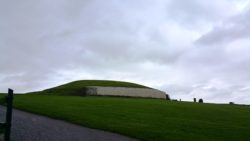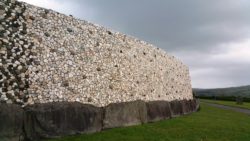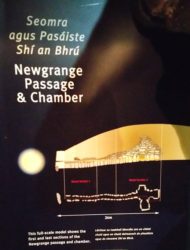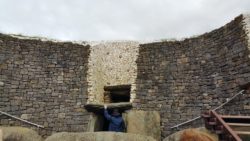 One of our first stops during our 2015 Ireland trip was Newgrange, a circular mound built more than 5,000 years ago during the Neolithic Period that houses a mystery. For perspective, think this: It is older than the Giza pyramids in Egypt.
One of our first stops during our 2015 Ireland trip was Newgrange, a circular mound built more than 5,000 years ago during the Neolithic Period that houses a mystery. For perspective, think this: It is older than the Giza pyramids in Egypt.

Never heard of Newgrange? I had not either, but after inching through a stone passage into the dark center of this tomb, I will never forget this monument, its chambers, its art.

Newgrange is what some call “a passage tomb” and others call a Sacred Temple. It sits on a hill surrounded by green grass in a perfect spot for catching the rays of the mid-winter sun at the Winter Solstice, allowing yellow beams straight through a high rectangular opening to flood the inner chambers with light.

BTW – about light
I am three-fourths of the way through Anthony Doerr’s, All the Light We Cannot See, which I bought in a bookstore in Dublin. I remember learning in high school science (when I was not dozing) that we don’t really see light. We only see the effects of light—colors—and the absence of light—shadows and darkness. Mmm…something to mull over when you can’t sleep.


Newgrange tour
Visitors can enter the Sacred Temple with a site-specific tour guide who explains the building of the tomb and how not one drop of rain has ever made its way through the circular rooftop. Now that’s stupendous! The soil inside has been dry for all those thousands of years.
You will see gorgeous spiral art in there, too, which is also on the enormous front entrance stone.
Inside, a few chambers may have been burial sites. They are in what would be the crosspiece since this tomb is in the shape of a cross.
The nearby modern museum (and great gift-shop) gives you more education on the site’s construction, the surrounding countryside and the Boyne River, the people who came together to build it, and the archaeologists who restored it, than you can possibly absorb, but it’s worth the visit!
Newgrange and two nearby smaller mounds, form a designated World Heritage Site.

Art of Newgrange
Artists for this site were consumed by the spiral design, often seen in other countries like Greece where they represent waves of the ocean, although the Greeks squared off the curves. You’ve probably seen that design on borders of ancient clothing depicted in frescos and on prehistoric pottery.
Musing over the spirals, they seemed to symbolize eternity, given this is a sacred place. Maybe they represent how our lives go in circles, or time, or creation/destruction/creation/destruction/creation…



For more info, visit: Newgrange
See you next time!







Adam
Another great informative read 🙂
The light part reminded what I read today about I. Newton that gave pause like you mentioned…
“Thus, he observed that colour is the result of objects interacting with already-coloured light rather than objects generating the colour themselves. This is known as Newton’s theory of colour.”
Charlene L. Edge
Love that I. Newton! Thanks for posting, Adam.